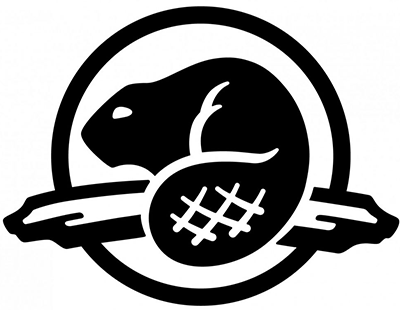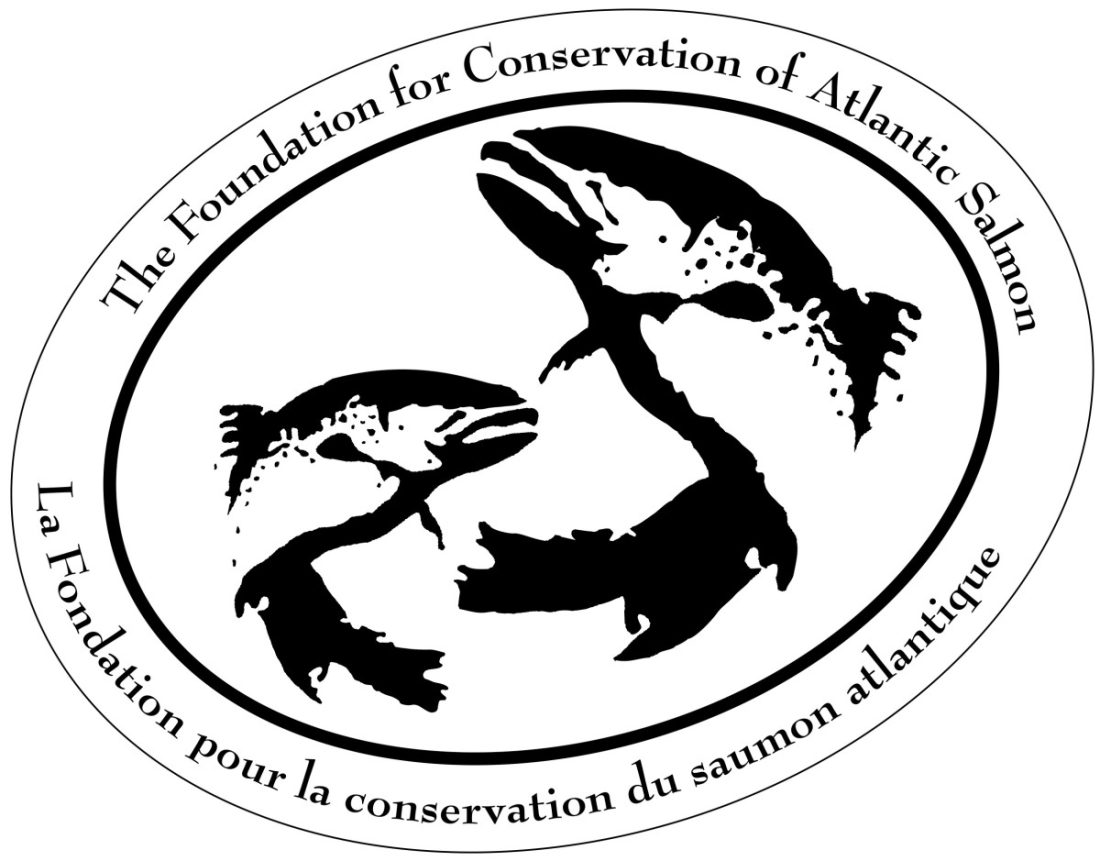The Big Salmon River
Smolt Wheel/RST Monitoring
A smolt wheel, also known as a Rotary Screw Trap (RST) is designed to catch a portion of the spring time juvenile salmon who are migrating out to the sea for the first time. Any salmon which swim into the smolt wheel are held and unharmed within its ‘live-well’ until technicians arrive to sample them. Data such as length and weight, and scale and tissue samples are collected from all salmon caught. A percentage of those fish captured are held for transport to the Live Gene Bank (LGB) at the Mactaquac Biodiversity facility where representation of surviving iBOF Atlantic salmon families are being maintained. Finally, some of the captured salmon are tagged using an upper caudal punch and recycled upriver to be recaptured by the smolt wheel once again. This helps determine the percentage of the smolt run that the smolt wheel is catching which allows us to estimate the size of the overall run.
A summary of the 2021 smolt wheel monitoring is as follows:
Our smolt wheel installed on the Big Salmon River began fishing on May 3rd. The RST was operated in joint partnership with Fisheries and Oceans Canada with fishing occurring 7 days a week from May 3rd to June 11th. In addition to the RST, a fyke net was installed on the Big Salmon River on May 30th in an effort to increase our daily smolt catches. The fyke net was in operation 5 days a week. This year’s total smolt catch on the Big Salmon River was 242. Of these, 81 were sampled and recycled, 35 were transported to Dark Harbour, and 117 were transported to Mactaquac Biodiversity Facility. The remaining 9 smolts were released for various reasons, including previously spending time in a hatchery.
A summary of the 2017 smolt wheel monitoring is as follows:
The Big Salmon River (BSR) rotary screw trap (RST) was installed in the Amateur Pool on April 26, 2017 and was set to fish on April 30, 2017. Amateur Pool is approximately 500 m above head-of-tide. The RST was last fished on June 15, 2017 and it was also removed on June 15, 2017. The RST was operated by FFHR staff with the assistance of the Mi’kmaw Conservation Group (MCG). Fishing occurred 7 days a week from May 1, 2017 until June 15, 2017, expect for four days (May 6 to May 9, 2017) when the water was exceptionally high and the wheel was raised (May 5, 2017) for safety. The wheel was reset on May 9, 2017 and was fished on May 10, 2017. There were four fish being held in the LGB live well during this time that were lost in the high water due to the live well being damaged by the fast water. The live well was repaired and reset.
The number of wild/hatchery released unfed fry origin smolts on the BSR RST for 2017 was 1,985, which was an increase from 2016 with 1,328 captured smolt. The number of smolt included in the marked-recapture experiment was 782. Of these 782 fish, 165 were recaptured in the RST. Based on these results, the 2017 RST had an efficiency of 21.1%.
A summary of the 2016 smolt wheel monitoring is as follows:
The RST or “smolt wheel” was installed in the Amateur Pool of the BSR, located approximately 500 meters above the head-of-tide. The smolt wheel was installed on April 28th and began fishing on May 1st, 2016 and was raised for the season on June 14th with removal on June 16th, 2016. The RST was operated in joint partnership between FFHR and the Mi’kmaw Conservation Group (MCG) with fishing occurring 7 days a week from May 1st until June 14th, 2015. The total RST smolt catch was 1,328. The assessment of origin, wild versus hatchery, of out migrating smolts carried out by field technicians is done by making note of the presence/ absence of the adipose fin. Hatchery reared juveniles released as un-fed fry would still have their adipose fins present where as hatchery reared juveniles released as fall fingerlings would have their adipose fins clipped. In the field, many smolts identified as wild would actually have been released from the hatchery as un-fed fry (with adipose fin intact) in previous years. Through genetic analysis of tissue samples taken during processing, DFO can differentiate between smolt resultant from LGB fry releases and those resultant from wild spawning. The number of wild smolt, as determined by the presence of their adipose fin, captured in the RST in 2016 was 1,328. The number of hatchery origin smolt, as determined by the absence of an adipose fin, captured in the RST was 0. The total number of smolt marked and recycled for the mark/recapture experiment was 678. Of those 678 marked fish, 90 were recaptured.
Two out of every five ‘wild’ smolt captured in the RST were sampled and retained in a live box prior to being transported to the Mactaquac Biodiversity Facility (MBF) for incorporation into the LGB program. The wild smolt were sampled for tissue, scale, length, weight and were implanted with a Passive Integrated Transponder or PIT tag. With a protocol to collect 2 of 5 smolt and a total number of 1328 wild salmon, a total of 513 iBoF Atlantic salmon smolts were collected, sampled, tagged and retained for inclusion into the LGB program. With an initial target collection number of BSR smolts of 300 we were successful at not only meeting but exceeding this target with 513 retained for inclusion into the LGB for 2016.
Snorkeling Surveys/Seining
Adult snorkeling surveys are carried out yearly in order to assess the number of returning fish to iBOF rivers. If possible, the seining of adults is attempted in order to provide scale and tissue samples for analysis. These surveys are conducted by technicians wearing dry suits and snorkel gear while snorkeling over main pools in the river. Seining involves using a net which hangs in the water using weights attached to the bottom of the net, while the remainder floats on top with small buoys. This creates a fence type structure which encircles fish, allowing technicians to capture and process them in a harmless manner.
A summary of the 2016 adult salmon snorkel and seine efforts are as follows:
On August 8th, 5 grilse and 2 salmon were observed in the lower section and 1 grilse was observed in the middle section. On September 7th, a snorkel survey resulted in observing 3 salmon and 8 grilse throughout the river (3 grilse at Miller, 3 grilse and 1 salmon at Catt Pool, 1 salmon at Long Pool and 2 grilse and 1 salmon at King pool). Due to low water levels and higher water temperatures the seining that was scheduled for September 8th and 9th were cancelled. On Oct 3rd, DFO seined Miller Pool in the lower section, successfully netting and sampling 4 of the 6 fish observed. On October 18th, all sections of the BSR were surveyed, with 1 female salmon and 3 grilse observed. Due to low numbers observed on October 18th, an additional swim of the upper and middle pools as well as the lower stretch was completed on November 8th, unfortunately no adult salmon were observed.
The Pollett and Little Rivers
Smolt Wheel/RST Monitoring & Counting Fence
A smolt wheel, also known as a Rotary Screw Trap (RST) is designed to catch a portion of the spring time juvenile salmon who are migrating out to the sea for the first time. Any salmon which swim into the smolt wheel are held and unharmed within its ‘live-well’ until technicians arrive to sample them. Data such as length and weight, and scale and tissue samples are collected from all salmon caught. From 2012 to 2013 all of the smolts caught at our Pollett River wheel were held and transported to the Mactaquac Biodiversity facility where they were retained for grow out and spawning, and released as either fry or adults back into the Petitcodiac system. In 2014, all smolt caught were held and transported to the Huntsman in St.Andrews where they are then transport to sea cages in Dark Harbour, Grand Manan. Starting in 2016 smolts collected are transported directly to Grand Manan, they are then grown out to adults and released back into the Petitcodiac system after 16-18 months as in previous years. Please see ‘Atlantic Salmon Projects’ under the ‘Projects’ tab for more information on our sea cage rearing project.
A summary of the 2021 counting fence and RST monitoring is as follows:
Although a variety of methods were used to fish the Pollett River this year, the primary method used was a counting fence. A V-shaped fence was installed across the width of the river, directing fish into a trap in the centre where they were held until technicians arrive. Fishing began on April 22nd and ended on June 4th, with a total of 498 smolts captured. 338 of these smolts were retained for Fundy Salmon Recovery. 145 smolts were given a small mark on their caudal fin (tail) and released upstream as part of a mark-recapture study to determine the efficiency of our trap, and 23 of those fish were caught a second time. In addition, data such as length and weight as well as tissue and scale samples were taken from a fraction of smolts encountered.
Along with salmon smolts, four adult salmon were encountered at the Pollett River this season. These salmon were previously caught by our program as smolts, and later received a Passive Integrated Transponder (PIT) tag before being released back into local watersheds. Using this PIT tag, we were able to determine information such as the date and location that these fish were caught as smolts as well as their length before release. In addition to this, many other species were also encountered including American eels, gaspereau, sea lampreys, brown bullheads, brook trout, white suckers and shiners.
A summary of the 2016 smolt wheel monitoring is as follows:
The smolt wheel was installed on the Pollett River April 26th 2016 and began fishing 7 days a week on May 1st. Due to periods of low flow it was raised periodically throughout the season, before it was raised for the season on June 21st, with removal on June 22nd, 2016. In addition to the smolt wheel, there were two fyke nets placed in the Pollett River. One fyke net was placed on May 5th upstream of the RST, and one placed downstream of the smolt wheel on June 1st, both remained fishing until July 7th, 2016. The number of wild smolt, as determined by the presence of their adipose fin, captured in the RST/Fyke nets in 2016 was 22. The number of hatchery origin smolt, as determined by the absence of an adipose fin, captured in the RST was 0.
Additionally, two fyke nets were installed in the Little River adjacent to Route 895 downstream of the bridge. Both fyke nets were installed on May 2nd and fished 7 days a week. While the downstream net was removed and relocated to the Pollett River on June 1st, the upstream net remained fishing until July 7th, 2016. The number of wild smolt, as determined by the presence of their adipose fin, captured in the fyke nets in 2016 was 5. The number of hatchery origin smolt, as determined by the absence of an adipose fin, captured was 0.
All wild smolt captured in the RST and Fyke Nets were sampled for tissue, scale, length, weight and were implanted with a Passive Integrated Transponder or PIT tag. In total, 27 out migrating smolts were captured (22 from the Pollett River and 5 from the Little River).
Snorkel Surveys
Adult snorkeling surveys are carried out yearly in order to assess the number of returning fish to iBOF rivers. These surveys are conducted by technicians wearing dry suits and snorkel gear while snorkeling over main pools in the river.
A summary of the 2015 surveys on the Little and Pollett River are as follows:
The Little River was snorkeled on Sept.23rd with no sightings of salmon. Water level was very low and not many pools were available to snorkel. The Pollett River was snorkeled on Aug 25th with 4 grilse observed in the upper pools by Gibson Falls. On Oct.8th, 2 grilse were observed and on Oct. 9th no fish were observed.
2016 snorkel surveys are being conducted in September and data will be available in October.












